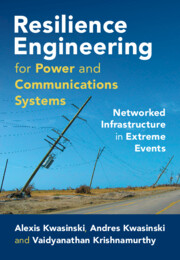 Resilience Engineering for Power and Communications Systems
Resilience Engineering for Power and Communications Systems Book contents
- Resilience Engineering for Power and Communications Systems
- Resilience Engineering for Power and Communications Systems
- Copyright page
- Contents
- Preface
- Acknowledgments
- 1 Introduction
- 2 Fundamental Supporting Concepts
- 3 Resilience Models and Metrics
- 4 Dependencies and Interdependencies and Their Effect on Resilience
- 5 Disaster Forensics of Infrastructure Systems
- 6 Electric Power Grid Resilience
- 7 Resilience of Information and Communication Networks
- 8 Integrated Electric Power and Communications Infrastructure Resilience
- 9 Infrastructure Systems Planning for Improved Resilience
- Index
- References
1 - Introduction
Published online by Cambridge University Press: 04 January 2024
- Resilience Engineering for Power and Communications Systems
- Resilience Engineering for Power and Communications Systems
- Copyright page
- Contents
- Preface
- Acknowledgments
- 1 Introduction
- 2 Fundamental Supporting Concepts
- 3 Resilience Models and Metrics
- 4 Dependencies and Interdependencies and Their Effect on Resilience
- 5 Disaster Forensics of Infrastructure Systems
- 6 Electric Power Grid Resilience
- 7 Resilience of Information and Communication Networks
- 8 Integrated Electric Power and Communications Infrastructure Resilience
- 9 Infrastructure Systems Planning for Improved Resilience
- Index
- References
Summary
The increased interest that the topic of critical infrastructure resilience is attracting in academia, government, commerce, services, and industry is creating an alternative engineering field that could be called resilience engineering. However, the views of the meaning of resilience have varied, and even in some very relevant world languages, an exact translation of the word “resilience” has only recently been introduced – for example, the word “resiliencia” was added to the dictionary of the Royal Academy of Spanish Language in 2014 – or it still does not exist, as happens in Japanese. Thus, this chapter introduces the main concepts associated with the study of resilience engineering applicable to critical infrastructure systems with a focus on electric power grids and information and communication networks (ICNs) because these are the infrastructures that are identified as “uniquely critical” in US Presidential Policy Directive 21, which is the source for the definition of resilience that is used in this book.
- Type
- Chapter
- Information
- Resilience Engineering for Power and Communications SystemsNetworked Infrastructure in Extreme Events, pp. 1 - 21Publisher: Cambridge University PressPrint publication year: 2024


